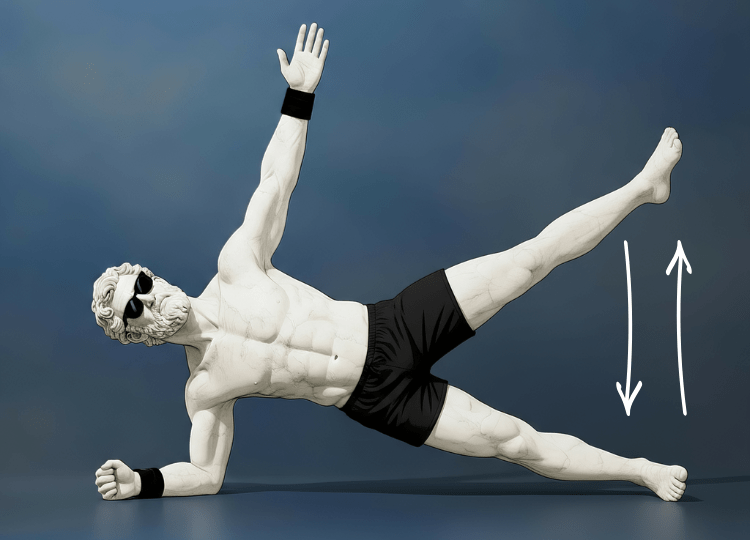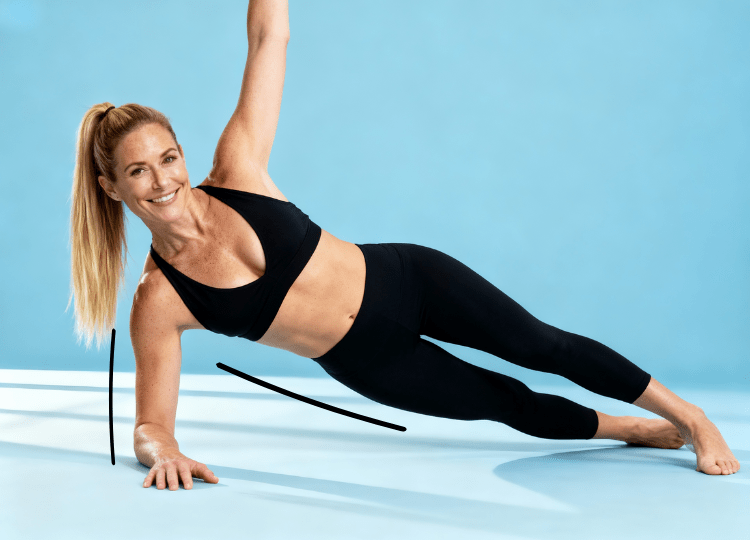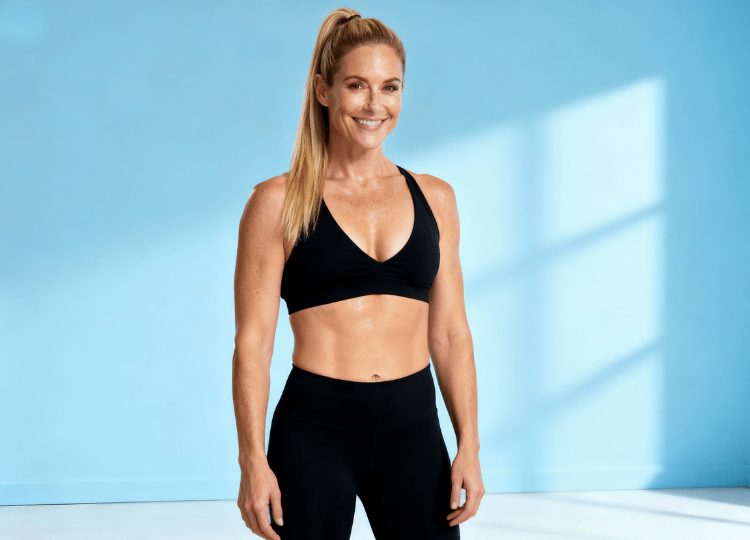Side planks alone are one of the most effective exercises for building core stability and targeting the often-neglected obliques.
But add a leg lift to the equation, and you’ve got an entirely different challenge.
This variation transforms a static hold into a dynamic movement that not only intensifies the work on your core but also fires up your hip abductors – particularly the gluteus medius, a crucial muscle for hip stability that many people struggle to activate properly.
If you’re looking to progress beyond basic side planks or want to address hip weakness and improve lateral stability, this exercise deserves a place in your training routine.
This blog is in partnership with our friends at Marble Guy – a YouTube channel for easy-to-follow workouts and exercise guides.

Quick Summary
- Side plank with leg lift involves holding a side plank position while raising and lowering your top leg.
- It primarily works the obliques, gluteus medius, and hip abductors while engaging the entire core.
- The leg lift component specifically targets hip stability and addresses common weaknesses.
- Start with standard side planks before progressing to this more challenging variation.
How to Perform Side Plank with Leg Lift

To do side plank with leg lift:
- Lie on your right side with your legs straight and stacked on top of each other.
- Place your right forearm on the ground with your elbow directly under your shoulder.
- Engage your core and lift your hips off the ground, creating a straight line from head to feet.
- Stack your left foot on top of your right foot (or slightly stagger them for more stability).
- Place your left hand on your hip or extend it toward the ceiling.
- Once stable, lift your top leg toward the ceiling, keeping it straight.
- Raise the leg until you feel strong contraction in your outer hip and obliques.
- Lower the leg back down with control, maintaining plank position throughout.
- Complete your reps on one side before switching to the other.
Coach’s Tip
Don’t rush into the leg lift. Establish a solid, stable side plank first, then add the leg movement. If your hips drop or rotate when you lift your leg, you’re not ready for this variation yet.
Key Form Cues
Maintain Hip Height
Your hips should stay elevated throughout the entire set. The most common mistake is letting your hips sag toward the ground, especially as you lift the leg. Think about actively pushing the ground away with your forearm.
Control the Leg Movement
This isn’t about how high you can kick your leg. Lift until you feel your outer hip working (usually 30-45 degrees), then lower with the same control. The quality of the movement matters far more than the range of motion.
Keep Your Body Aligned
Imagine your body is sandwiched between two panes of glass. You shouldn’t rotate forward or backward – everything should stay in the same plane. Your chest should face forward, not toward the ground.

Stabilize Your Shoulder
Your supporting shoulder does significant work. Push actively into the ground and avoid letting your shoulder collapse. Think about creating space between your ear and shoulder.
Foot Position
Keep your top foot flexed (toes pointing forward) as you lift. This engages the hip muscles more effectively than pointing the toes.
Breathing Pattern
Exhale as you lift your leg up, inhale as you lower it down. This breathing rhythm helps maintain core tension and prevents you from holding your breath, which is common when people struggle with balance.
Tempo Recommendations
A controlled tempo yields the best results:
- 2 seconds to lift the leg up
- 1 second pause at the top
- 2 seconds to lower the leg down
This slower tempo increases time under tension and forces your stabilizing muscles to work harder. Avoid bouncing or using momentum.
Progression Path
If you’re new to this exercise, follow this progression:
- Standard Side Plank – Hold for 30-45 seconds per side with perfect form
- Side Plank with Top Leg Forward – Place your top foot slightly in front of your bottom foot for a more stable base, then add small leg lifts
- Full Side Plank with Leg Lift – Perform the complete movement with feet stacked
- Add Resistance – Use ankle weights or resistance bands once you’ve mastered the bodyweight version
Don’t skip steps. Each progression builds the strength and stability needed for the next level.

Muscles Worked
This exercise engages far more muscles than you might expect from watching someone perform it.
Obliques (Internal and External)
Your obliques work overtime to prevent your torso from rotating and keep your spine stable. The internal obliques on your supporting side work particularly hard to maintain the side plank position.
When you lift your leg, the demand on your obliques increases significantly because your base of support becomes even smaller.
Gluteus Medius
This is where the leg lift really shines. The gluteus medius, located on the outer part of your hip, is responsible for hip abduction (moving your leg away from your body).
This muscle is critically important for hip stability during single-leg activities like walking, running, and climbing stairs. Weakness here contributes to knee pain, lower back pain, and poor movement patterns.
The leg lift specifically targets this often-underdeveloped muscle in a way that traditional exercises like squats and deadlifts don’t address.
Gluteus Minimus
Working alongside the gluteus medius, the gluteus minimus assists with hip abduction and stabilization. It’s the smallest of the three glute muscles but plays a vital role in lateral stability.
Tensor Fasciae Latae (TFL)
Located on the outer hip, the TFL assists with hip abduction and helps stabilize the pelvis during the movement. It works in conjunction with the IT band to maintain leg position.
Quadratus Lumborum (QL)
This deep core muscle on the supporting side works to prevent your torso from side-bending. It’s often a source of lower back pain when weak or tight, making exercises that strengthen it valuable for back health.
Transverse Abdominis
The deepest layer of abdominal muscles acts like a corset, creating intra-abdominal pressure and spinal stability. It works constantly throughout the exercise to maintain your position.
Shoulder Stabilizers
Your supporting shoulder complex, including the rotator cuff muscles, works hard to maintain arm position and prevent your shoulder from collapsing under your body weight.
Hip Flexors (on the lifting leg)
The hip flexors assist with lifting and controlling the leg, particularly if you’re lifting slightly forward of pure vertical.

Side Plank Leg Lifts Benefits (and Why Include a Leg Lift)
Before diving into the leg lift variation, it’s worth understanding why side planks themselves are so effective.
Standard side planks are superior to traditional planks for oblique development because they create a lateral stability challenge that front planks don’t provide. They teach your core to resist rotation and side-bending, which is crucial for athletic performance and injury prevention.
Most people have significantly stronger anterior core (front) than lateral core (side), making side planks a necessary component of balanced core training.
Adding the leg lift takes an already effective exercise and amplifies its benefits in several key ways:
Targets Hip Abduction Weakness
Most gym-goers have weak hip abductors because traditional compound exercises like squats and deadlifts don’t adequately challenge these muscles. The leg lift directly addresses this common weakness.
Weak hip abductors contribute to knee valgus (knees caving inward during squats), IT band issues, and poor running mechanics. Strengthening them improves movement quality across virtually all lower body exercises.
Increases Core Challenge
When you lift your top leg, you reduce your base of support and shift your center of gravity. This forces your core to work significantly harder to maintain stability compared to a static side plank.
Develops Dynamic Stability
Static holds build one type of strength, but adding movement requires your muscles to stabilize while also controlling motion. This dynamic stability is more functional and carries over better to real-world activities.
Improves Hip Mobility
The leg lift takes your hip through a range of motion that many people rarely use. Over time, this can improve hip mobility and reduce stiffness, particularly if you spend long periods sitting.
Enhances Mind-Muscle Connection
The leg lift forces you to focus on both maintaining plank position and controlling leg movement simultaneously. This builds better body awareness and coordination.
Addresses Muscle Imbalances
You’ll likely discover one side is significantly weaker than the other. This unilateral work helps identify and correct these imbalances before they lead to injury or movement compensations.
Comparison to Similar Exercises
Side Plank with Leg Lift vs Fire Hydrants
Fire hydrants (on hands and knees, lifting one leg to the side) also target the hip abductors but don’t challenge core stability in the same way. Side plank with leg lift is more time-efficient because it works both simultaneously.
However, fire hydrants allow you to lift your leg higher and focus purely on hip abduction without the balance challenge. Both exercises have value, but the side plank variation is more functional.
Side Plank with Leg Lift vs Clamshells
Clamshells are excellent for glute medius activation but are performed lying down with minimal core engagement. They’re better for isolation and rehabilitation work.
Side plank with leg lift is more advanced and integrates core and hip stability in a weight-bearing position. Use clamshells for activation or rehab, and side plank with leg lift for functional strength development.
Side Plank with Leg Lift vs Side-Lying Hip Abduction
Side-lying leg lifts (lying on your side and lifting your top leg) isolate the hip abductors without the core component. They’re easier to perform and allow for higher reps or added resistance.
The side plank variation is superior for developing integrated strength and stability but requires more technical proficiency. Both can coexist in a program – use side-lying variations for higher-rep accessory work and side plank with leg lift for comprehensive core and hip training.
Side Plank with Leg Lift vs Copenhagen Planks
Copenhagen planks (side plank with top leg elevated on a bench) are significantly more challenging and emphasize the adductors (inner thigh) of the top leg rather than the abductors.
These are two different exercises targeting different muscle groups. Copenhagen planks are more advanced and better for athletes needing strong adductors (soccer players, hockey players). Side plank with leg lift is more accessible and targets hip stability more directly.

When to Prioritize This Exercise
Include side plank with leg lift in your program if:
- You have weak hip abductors or struggle with knee stability
- You experience knee cave during squats or lunges
- You’re a runner dealing with IT band issues or knee pain
- You want to improve single-leg strength and stability
- Your training lacks sufficient lateral core work
- You’ve mastered standard side planks and need progression
Real-World Carryover
The stability developed from this exercise translates directly to:
- Better running mechanics and reduced injury risk
- Improved balance on uneven terrain
- Stronger single-leg movements like lunges and step-ups
- Enhanced performance in rotational sports (tennis, golf, baseball)
- Reduced lower back pain from better lateral stability
- Improved posture during prolonged standing
Common Mistakes to Avoid
Hips Dropping Toward the Ground
This is by far the most common mistake. As you fatigue or lift your leg, your hips sag toward the floor, reducing core engagement and putting strain on your lower back.
If this happens, you’ve reached failure on that set. Rest, reset, and either perform fewer reps or choose an easier modification.
Fix: Actively push the ground away with your supporting forearm and think about lifting your hips toward the ceiling, slightly overexaggerating the position.
Rotating the Torso
When people struggle with stability, they often rotate their chest toward the ground or ceiling to compensate. This completely defeats the purpose of the exercise.
Your torso should remain in the same plane throughout – if someone is standing in front of you, your chest should face them the entire time.
Fix: Practice the exercise facing a wall about 12 inches away. If your chest touches the wall or you start facing away from it, you’re rotating.
Swinging the Leg
Using momentum to throw your leg up reduces the effectiveness of the exercise. The hip abductors do minimal work when you’re swinging rather than controlling the movement.
Fix: Slow down dramatically. Count to two as you lift, pause for one second, count to two as you lower. If you can’t control this tempo, reduce your range of motion.
Lifting the Leg Too High
More range of motion isn’t always better. Lifting your leg too high often causes your pelvis to tilt, your torso to rotate, or your form to break down in other ways.
Most people only need to lift 30-45 degrees to maximally engage the hip abductors. Going higher recruits different muscles and often compromises stability.
Fix: Lift only until you feel strong contraction in your outer hip. If you’re not sure where that is, start with very small lifts and gradually increase until you feel the target muscles working.
Collapsing Through the Shoulder
When your supporting shoulder isn’t engaged, it collapses under your body weight, creating a “sinking” appearance and putting unnecessary strain on the joint.
Fix: Actively push the ground away throughout the entire set. Imagine trying to create space between your shoulder and the ground. Your shoulder blade should feel engaged and stable, not loose.
Holding Your Breath
Many people unconsciously hold their breath during challenging exercises, which limits performance and can spike blood pressure unnecessarily.
Fix: Establish a consistent breathing pattern – exhale on the lift, inhale on the lower. If you find yourself holding your breath, you’re probably using too difficult a variation.
Not Addressing Side-to-Side Differences
Most people have one side that’s significantly weaker. The natural tendency is to do fewer reps on the weaker side because it’s harder, but this perpetuates the imbalance.
Fix: Always start with your weaker side and match the reps on your stronger side. Over time, this helps balance out the asymmetry.
Bottom Line
Side plank with leg lift is a challenging progression that transforms the standard side plank into a comprehensive core and hip stability exercise.
While regular side planks effectively target the obliques and build lateral core strength, adding the leg lift introduces significant hip abductor work – specifically targeting the gluteus medius, a muscle that’s chronically weak in many people.
Whether you’re an athlete looking to improve performance, a runner dealing with knee issues, or simply someone wanting comprehensive core and hip development, side plank with leg lift offers unique benefits that complement traditional strength training exercises.
Related Articles:
Single Leg RDLs (Romanian Deadlifts)
